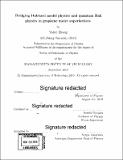Bridging Hubbard model physics and quantum Hall physics in graphene moire superlattices
Author(s)
Zhang, Yahui,Ph.D.Massachusetts Institute of Technology.
Download1200202338-MIT.pdf (13.43Mb)
Other Contributors
Massachusetts Institute of Technology. Department of Physics.
Advisor
Senthil Todadri.
Terms of use
Metadata
Show full item recordAbstract
This thesis is focused on the strongly correlated physics of graphene moiré superlattices formed in twisted bilayer graphene (TBG), twisted double bilayer graphene (TDBG) and ABC trilayer graphene aligned with hexagon boron nitride (TLG-hBN). First, I will show that the physics of these systems can be divided into two categories: (1)The nearly-flat bands have non-zero valley Chern number, which leads to "quantum Hall physics" including integer and fractional quantum anomalous Hall effect and composite fermi liquid (CFL) physics. (2) The narrow bands have trivial band topology. In this case the essential physics is captured by a Hubbard like lattice model similar to that of the high T[subscript c] cuprates. Both of the above two classes have already been realized in the experiments. I will discuss how current and future experiments on these moiré materials can deepen our understanding of the cuprate physics and quantum Hall physics. In addition, I will also propose several new phases in moiré systems, which have never been studied before. These include featureless and orthogonal pseudogap metals and quantum Hall spin liquids.
Description
Thesis: Ph. D., Massachusetts Institute of Technology, Department of Physics, 2019 Cataloged from PDF of thesis. Includes bibliographical references (pages 139-152).
Date issued
2019Department
Massachusetts Institute of Technology. Department of PhysicsPublisher
Massachusetts Institute of Technology
Keywords
Physics.